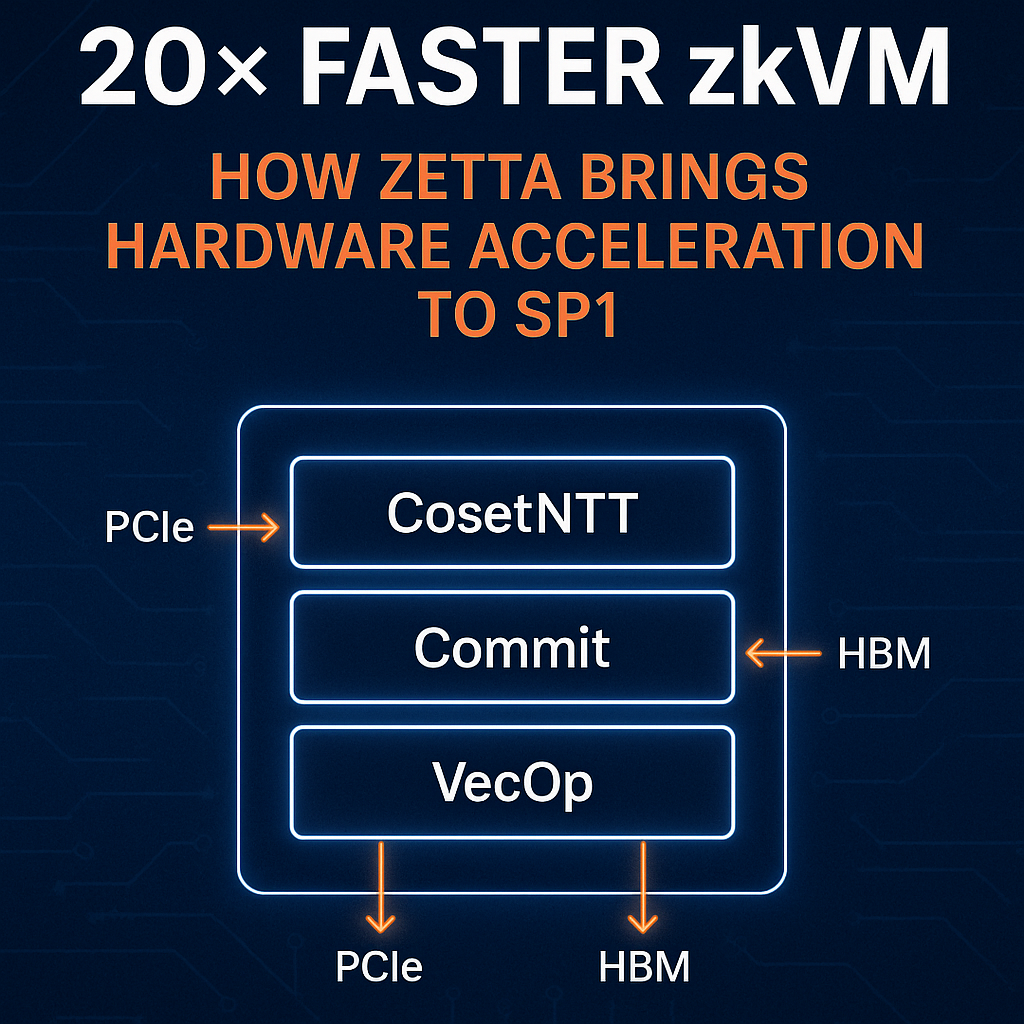20× Faster zkVM: How Zetta Brings Hardware Acceleration to SP1

Introduction
If there’s one white-hot corner in crypto right now, it’s zkVMs. “The pace of progress is mind‑blowing,” says Ethereum Foundation’s Justin Drake. Today, we’re tearing down barriers with Zetta, the world’s first FPGA-based zkVM accelerator for SP1 Cranking proof generation to 20× faster than CPUs.
zkVM 101: Why Hardware Acceleration?
- A zkVM lets developers write programs in familiar languages like Rust or C++, then transparently converts them into zero-knowledge proofs—no cryptic circuit design needed.
- But building proofs, especially on general hardware, is painfully slow.
- That's why hardware acceleration particularly FPGAs is the breakthrough we’ve been waiting for theblockbeats.info+7medium.com+7x.com+7blog.succinct.xyzarxiv.org+4hackmd.io+4ingonyama.com+4blog.succinct.xyz+5paradigm.xyz+5medium.com+5.
Meet Zetta: The Architecture That Delivers
Zetta is designed specifically for SP1’s proof generation, implemented on an AMD Alveo U55C FPGA, and built around a modular, high-performance FPGA design blog.succinct.xyz+1medium.com+1. Here’s how it works:

- CosetNTT — Lightning-fast number-theoretic transforms
- Commit — Efficient Merkle-tree operations
- VecOp — Handles complex tasks like permutation traces, quotient computation, FRI folding, and more
All connected to High Bandwidth Memory (HBM) and controlled via PCIe, enabling massive parallel throughput.
Flexibility: Any Chip, Any Time
Rather than hard-coding circuits, VecOp uses programmable instruction sequences, meaning any SP1 “chip” logic can be accelerated—now or in the future.
Why Zetta’s Modular Design Matters
Zetta splits its logic into three independent modules with dedicated task queues so different operations can run in parallel, avoiding bottlenecks and keeping utilization high.
Performance Benchmarks That Matter
On real workloads from the zkvm-perf suite, Zetta hits:
- Loop-300m: 260s vs 4,692s (≈18× faster)
- SHA256-10 MB: 557s vs 7,746s (≈14× faster)
- Overall range: 15×–20× speedups over 64-core Xeon CPUs blog.succinct.xyz+1people.csail.mit.edu+1people.csail.mit.edu+1hackmd.io+1
Why This Matters: FPGA → ASIC Pathway
FPGAs offer a real-time acceleration stopgap flexible and fast. But the real goal is ASICs. Zetta proves the concept, builds IP, and directs the design for future application‑specific chips medium.com+11blog.succinct.xyz+11twitter.com+11.

Bigger Picture: SP1 & Succinct’s Road Ahead
- This makes SP1 the first production-ready RISC-V zkVM with live FPGA acceleration on the Succinct Prover Network twitter.com+7blog.succinct.xyz+7blog.succinct.xyz+7.
- AntChain OpenLabs is already contributing hardware teams to continually improve performance.
- This is real-world proof that incentive-aligned, hardware-backed proving is possible.
“Zetta makes SP1 20× faster—real-time zero-knowledge proving just went mainstream.”
“From FPGA to ASIC, Zetta paves the path to fast, reliable, scalable zkVMs.”
Want to Dive Deeper?
- Read the full Zetta architecture breakdown on Succinct’s blog blog.succinct.xyz+8blog.succinct.xyz+8x.com+8people.csail.mit.edu+1blog.succinct.xyz+1blog.matter-labs.io+2theblockbeats.info+2zellic.io+2.
- Understand why FPGAs are the sweet spot between GPUs and ASICs people.csail.mit.edu+15paradigm.xyz+15hackmd.io+15.
- Explore hybrid design ideas that combine fpga flexibility and ASIC scale .
🏁Conclusion
Zetta is more than speed it’s a blueprint. By marrying zkVM flexibility with hardware muscle, we’re pushing zero-knowledge proving into real-time, cost-efficient, and scalable territory. SP1 isn’t just secure, it’s now fast enough for production, setting a new industry standard.
Ready to build on SP1? Keep your eyes on the evolving Falcon Prover Network where real hardware acceleration becomes part of the ecosystem.
INTERNAL LINKS:
SP1 zkVM
Succinct SP1 zkVM
Real-World Impact: SP1 in Production
A New Era for Rust Developers
What is zkVM



Comments ()